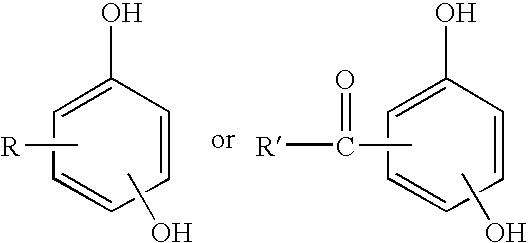Curable base-resistant fluoroelastomers
a fluoroelastomer and base-resistant technology, applied in the direction of tyre parts, textiles and paper, solid separation, etc., can solve the problems of unsatisfactory curing unsatisfactory polyhydroxy and peroxide cure process or curing agent formulation, and unsatisfactory cured products, etc., to achieve the physical properties and adhesion of tfe/p copolymers, cure characteristics, and adh
- Summary
- Abstract
- Description
- Claims
- Application Information
AI Technical Summary
Benefits of technology
Problems solved by technology
Method used
Image
Examples
example 1
[0053]A fluoroelastomer of the invention (Polymer 1) was prepared by a semi-batch emulsion polymerization, carried out at 60° C. in a well-stirred reaction vessel. A 33-liter, horizontally agitated reactor was charged with 22 liters of deionized, deoxygenated water, 383 g of Zonyl® 1033D, 10.4 g of sodium hydroxide and 21 g of isopropanol. The reactor was heated to 60° C. and then pressurized to 2.07 MPa with a mixture of 96.0 wt. % TFE, 2.0 wt. % P, and 2.0 wt. % 3,3,3-trifluoropropene-1 (TFP). A 540 ml aliquot of an aqueous 10 wt. % ammonium persulfate initiator solution was then added. A mixture of 78.4 wt. % TFE, 17.5 wt. % P, and 4.1 wt. % TFP was supplied to the reactor to maintain a pressure of 2.07 MPa throughout the polymerization. After 80 g of gaseous monomer had been fed to the reactor, a feed of 4-bromo-3,3,4,4-tetrafluorobutene-1 (BTFB) was begun at a rate of 35.1 ml per 3000 g gaseous monomer until 88.0 ml had been fed to the reactor. The initiator solution was fed co...
example 2
[0054]Curable compositions of the invention (Samples 1 and 2) were made by mixing a fluoroelastomer of the invention (Polymer 1) with a salt of a polyhydroxy curative and vulcanization accelerator (1:1 molar ratio methyltributylammonium / bisphenol AF) and other ingredients on a conventional two-roll rubber mill, using standard mixing techniques employed in the elastomer industry. Comparative curable compositions (Samples A and B) were made by the same procedure except that control fluoroelastomer Polymer A (not containing BTFB cure site monomer units) was used in place of Polymer 1. Another comparable curable composition (Sample C) was made by mixing an organic peroxide curative with control Polymer B (not containing TFP cure site monomer units). The formulations are shown in Table I.
[0055]O-rings were made by press curing 10 minutes at 177° C. followed by an air oven post cure of 16 hours at 200° C. Physical properties, compression set resistance and adhesion were measured according...
PUM
| Property | Measurement | Unit |
|---|---|---|
| pressure | aaaaa | aaaaa |
| pressure | aaaaa | aaaaa |
| temperature | aaaaa | aaaaa |
Abstract
Description
Claims
Application Information
 Login to View More
Login to View More - R&D
- Intellectual Property
- Life Sciences
- Materials
- Tech Scout
- Unparalleled Data Quality
- Higher Quality Content
- 60% Fewer Hallucinations
Browse by: Latest US Patents, China's latest patents, Technical Efficacy Thesaurus, Application Domain, Technology Topic, Popular Technical Reports.
© 2025 PatSnap. All rights reserved.Legal|Privacy policy|Modern Slavery Act Transparency Statement|Sitemap|About US| Contact US: help@patsnap.com



